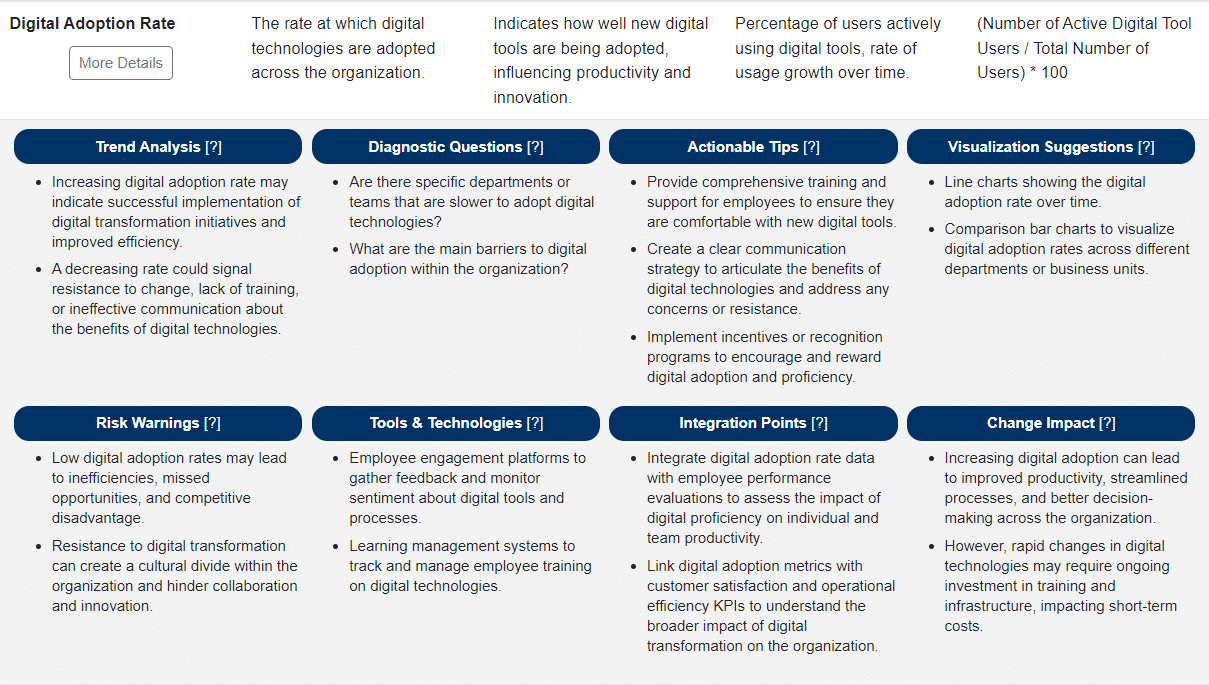Editor's Note: Take a look at our featured best practice, Cost Segregation Study: Multiple Property Class Analysis (Excel workbook). Accountants, accounting firms, and real estate property owners can all benefit from this cost segregation study (CSS) template. It makes the estimated benefit easy to figure out and has flexible assumptions for high level or detailed segregation analysis. You get a summary of cost [read more]
KPI Management: Digital Transformation Strategy KPIs
* * * *

Digital Transformation Strategy encompasses the integration of digital technology into all areas of an organization, fundamentally changing operations and business models. This strategic pivot is essential for enhancing competitiveness, improving customer experience, and fostering innovation. As organizations navigate this complex journey, identifying and tracking the right KPIs is vital for measuring progress, optimizing processes, and ensuring alignment with overarching business objectives.
This article explores the key KPIs associated with Digital Transformation Strategy, highlighting their role in facilitating informed decision-making and effective strategy implementation. We aim to provide executives and senior managers with a clear understanding of how these KPIs can serve as a compass during Digital Transformation efforts, ensuring that initiatives are data-driven, focused, and aligned with the organization’s strategic vision. By leveraging these KPIs, organizations can navigate the Digital Transformation landscape with greater confidence and achieve sustained success in the digital age.
Importance of Digital Transformation Strategy
Digital Transformation Strategy is not merely about adopting new technologies, but about reimagining business models and processes for the digital era. This transformation is crucial for staying relevant in an increasingly digital world where customer expectations are constantly evolving, and competition is intensifying.
The strategic use of digital technologies can lead to significant improvements in efficiency, customer engagement, and innovation, driving growth and creating new value propositions. The KPIs associated with this functional group offer actionable insights into the effectiveness of digital initiatives, enabling organizations to measure their progress, refine their strategies, and achieve their digital aspirations.
Challenges to Digital Transformation
Embarking on a Digital Transformation Journey presents a myriad of challenges, including technological integration, cultural change, and aligning digital initiatives with business goals. Organizations often struggle with identifying the right technologies to invest in, managing the change process, and quantifying the impact of digital initiatives. Furthermore, the fast-paced nature of Digital Innovation can make it difficult to maintain a competitive edge.
The KPIs related to Digital Transformation Strategy are designed to address these challenges by providing a framework for tracking the progress of digital initiatives, evaluating their impact on operational and strategic objectives, and guiding continuous improvement efforts. Through a focused approach to KPI tracking, organizations can overcome the common hurdles of Digital Transformation and pave the way for a successful digital future.
Top 10 Digital Transformation Strategy KPIs
The journey towards Digital Transformation is complex and multifaceted, requiring a strategic approach informed by relevant and actionable KPIs. Here are the top 10 KPIs essential for guiding a Digital Transformation Strategy, selected for their broad applicability and critical importance across industries. These KPIs are selected from the Flevy KPI Library, a robust database of over 15,000+ KPIs.
1. Digital Adoption Rate
- Definition: Measures the extent to which digital technologies are being utilized within the organization.
- Relevance: A high digital adoption rate indicates successful integration of digital tools, platforms, and practices, which is fundamental for realizing the benefits of Digital Transformation.
2. Digital Revenue Contribution
- Definition: The percentage of total revenue generated from digital channels and products.
- Relevance: This KPI highlights the financial impact of digital initiatives, underscoring the importance of digital channels in driving growth and profitability.
3. Customer Digital Engagement Index
- Definition: Quantifies the level of engagement customers have with the organization’s digital platforms and services.
- Relevance: Enhanced digital engagement is often associated with higher customer satisfaction, loyalty, and ultimately, revenue growth.
4. Digital Transformation ROI
- Definition: The return on investment for Digital Transformation initiatives, calculated by comparing the benefits gained to the costs incurred.
- Relevance: Tracking ROI is crucial for evaluating the effectiveness of Digital Transformation efforts and justifying future investments in technology.
5. Agile Practice Adoption Rate
- Definition: The rate at which agile methodologies are adopted across projects and teams within the organization.
- Relevance: Agile practices are key to increasing organizational flexibility, improving product development cycles, and enhancing responsiveness to market changes.
6. Digital Skills Proficiency
- Definition: Measures the level of digital literacy and technical skills across the organization’s workforce.
- Relevance: A skilled workforce is essential for leveraging new technologies effectively and fostering a culture of innovation.
7. Cloud Migration Status
- Definition: Tracks the progress of moving data, applications, and services to cloud computing environments.
- Relevance: Cloud migration is a critical component of Digital Transformation, offering scalability, flexibility, and cost-efficiency benefits.
8. Data Utilization Index
- Definition: Evaluates the extent to which data is being effectively collected, analyzed, and used to inform decision-making.
- Relevance: Effective data utilization enables data-driven decision-making, enhancing operational efficiency and competitive advantage.
9. Digital Project Delivery Time
- Definition: The average time taken to deliver digital projects from initiation to completion.
- Relevance: Reducing project delivery times can significantly increase agility and the organization’s ability to bring innovations to market quickly.
10. Cyber Security Incident Frequency
- Definition: The number of cyber security incidents recorded over a specific period.
- Relevance: In the digital age, maintaining strong cyber security is paramount to protect sensitive data and ensure business continuity.
To dig deeper into any of these KPIs, we invite you to explore the Flevy KPI Library, which allows you to drill down into 12 attributes for each KPI in the database. Here is an example for our top ranked KPI, Digital Adoption Rate.
Case Studies and Success Stories
Transforming Customer Experience through Digital Engagement
A retail company embarked on a Digital Transformation Journey with a focus on enhancing the “Customer Digital Engagement Index.” Recognizing the potential to drive growth through improved online customer experiences, the company revamped its digital platforms to offer more personalized and interactive services.
The organization utilized advanced analytics to understand customer behaviors and preferences, enabling the creation of tailored marketing messages and recommendations. Additionally, they integrated chatbots and AI-driven support to ensure 24/7 customer service, aiming to improve the overall digital customer journey.
Outcome: As a result of these initiatives, the company witnessed a significant increase in customer engagement on its digital platforms, reflected in a 40% rise in the Customer Digital Engagement Index. This uptick in engagement directly contributed to a 25% increase in “Digital Revenue Contribution”, showcasing the financial impact of enhanced digital customer interactions.
Lessons Learned: Investing in personalized and responsive digital customer experiences can substantially boost engagement and revenue. Leveraging data to understand customer needs and integrating technology to meet those needs in real-time are key to successful Digital Transformation.
Accelerating Innovation through Agile Adoption
A financial services firm faced challenges in responding to market changes and delivering digital projects promptly. To improve agility and innovation, the firm focused on the “Agile Practice Adoption Rate” KPI, aiming to embed agile methodologies across its Digital Transformation projects.
The company initiated comprehensive training programs to instill agile principles and practices among its teams. It also restructured its project management processes to foster cross-functional collaboration and rapid iteration, allowing for quicker feedback loops and adjustments.
Outcome: The adoption of agile practices led to a significant reduction in “Digital Project Delivery Time”, with the average project completion time dropping by 30%. This acceleration in project delivery enabled the firm to launch new digital services faster, gaining a competitive edge in the market. Furthermore, the “Digital Transformation ROI” saw a marked improvement, indicating the financial success of adopting agile methodologies.
Lessons Learned: Embracing agile practices can greatly enhance an organization’s ability to innovate and respond to market demands swiftly. Training and cultural change are essential components of successfully integrating agile methodologies into Digital Transformation efforts.
Additional Resources and Further Reading
Foremost, if you are in the process of selecting or refreshing your Corporate Strategy KPIs, take a look at the Flevy KPI Library. With over 15,000+ KPIs, our KPI Library is one of the largest databases available. Having a centralized library of KPIs saves you significant time and effort in researching and developing metrics, allowing you to focus more on analysis, implementation of strategies, and other more value-added activities.
Here are other KPI Strategy and KPI Management articles we’ve published:
- Principles of KPI Selection. This article breaks down the 8 guiding principles to KPI selection and provides several case studies on how to use these principles in practice.
- Principles of KPI Maintenance. It’s important to recognize that as market conditions and strategic objectives evolve, so too must the KPIs. This article provides a disciplined approach to maintaining KPIs.
- KPI Dashboard Design & Visualization. Learn the art and science of designing KPI dashboards, including types of data visualization and how to choose among them.
- Anatomy of a Strong KPI. Learn what makes a KPI effective, discussing the characteristics of KPIs that are most impactful and how they can drive strategic business decisions.
- 10 Common Pitfalls in KPI Implementation. Learn how to identify and remediate the 10 most common pitfalls in KPI implementation. If left unfixed or as unknowns, these pitfalls can have disastrous, long-term impacts on the organization.
- KPIs and Organizational Alignment . This article discusses the concepts of strategic, tactical, and operational KPIs; as well as balancing individual, team, and organizational objectives.
- Integrating KPIs into Employee Performance. This article discusses 5 methods for integrating KPIs into individual performance metrics; and includes several case studies.
- Integrating KPIs into the Organizational Culture. This article breaks down 4 strategies for embedding KPIs into the Corporate Culture; also includes several case studies.
- Future-Proofing KPIs. Understand how to “future-proof” KPIs by understanding the impacts of emerging market trends, emerging technologies, and evolving consumer behaviors on KPIs.
- KPIs and Digital Transformation. All organizations are undergoing Digital Transformations. Learn how to define, select, and implement relevant Digital Transformation KPIs.

Do You Want to Implement Business Best Practices?
You can download in-depth presentations on 100s of management topics from the FlevyPro Library. FlevyPro is trusted and utilized by 1000s of management consultants and corporate executives.
For even more best practices available on Flevy, have a look at our top 100 lists:
- Top 100 in Strategy & Transformation
- Top 100 in Digital Transformation
- Top 100 in Operational Excellence
- Top 100 in Organization & Change
- Top 100 Management Consulting Frameworks
These best practices are of the same as those leveraged by top-tier management consulting firms, like McKinsey, BCG, Bain, and Accenture. Improve the growth and efficiency of your organization by utilizing these best practice frameworks, templates, and tools. Most were developed by seasoned executives and consultants with over 20+ years of experience.
Readers of This Article Are Interested in These Resources

|
|
145-slide PowerPoint presentation
|
|
Excel workbook
| |||
About Flevy Management Insights
Top 10 Recommended Documents














